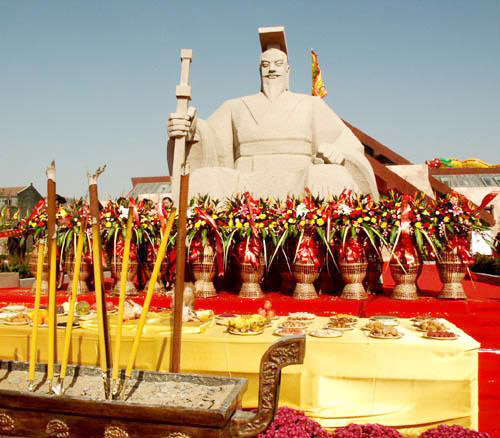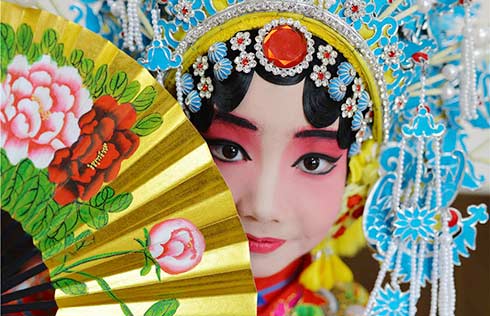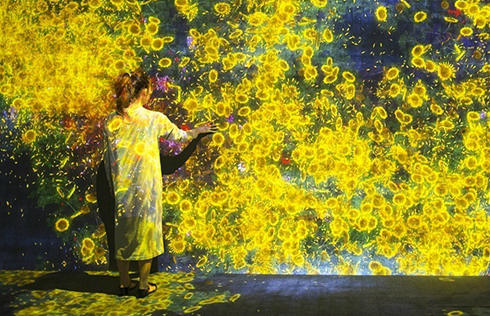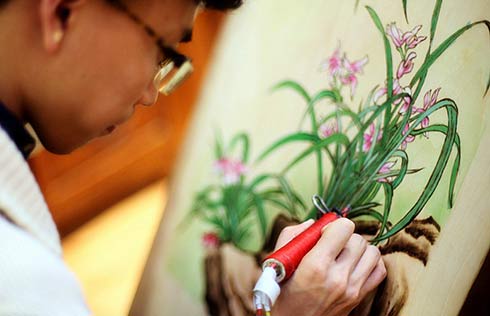

 |
|
[Photo/Agencies] |
Huang-di, or the Yellow Emperor, is a legendary Chinese sovereign and cultural hero who is considered in Chinese mythology to be the ancestor of all Han Chinese. He was one of the legendary Five Emperors. He was mentioned in the Shiji by historian Sima Qian (145 BCE-90 BCE). Tradition holds that he reigned from 2697 BC to 2597 BC. His personal name was said to be?Gongsun Xuanyuan. He emerged as a chief deity of Taoism during the Han Dynasty (202 BCE-220 CE).
Among his many accomplishments, Huangdi has been credited with the invention of the principles of Traditional Chinese medicine. The Huangdi Neijing (Inner Canon of Huangdi) was supposedly composed in collaboration with his physician Qibo. However, modern historiographers generally consider it to have been compiled from ancient sources by a scholar living between the Zhou and Han dynasties, more than 2,000 years later.
His interest in natural health and the prevention and treatment of diseases, according to historical sources, allowed him to live until the age of 100, and attain immortality after his physical death.
Legends
In legend, his wife Lei Zu taught the Chinese how to weave silk from silkworms, and his historian Cong Jie created the first Chinese characters.
His conception was supposed to have been signaled by a thunderclap on a clear day by the Heavens.
Legend says that Huangdi became the leader of his tribe which bore the totem of a bear (Youxiong, lit. possess bears). His tribe went to war with a neighboring tribe bearing the totem of a bull, headed by Yandi. Huangdi, through his superior military and leadership skills won the war and subdued Yandi's tribe. The two tribes united and became one. Legend then says that the Chinese civilization began with these two tribes. Some sources name Yandi as a brother or half-brother.
Huangdi's people were then threatened by a tribe under the leadership of Chi You, who was said to have magical powers and had 81 brothers, each having 4 eyes and 8 arms wielding terrible sharp weapons in every hand. Huangdi called upon 8 neighboring tribes to join forces with him and sent the combined army to meet Chi You and his brothers. The two great armies fought for days without a clear winner. Just as Huangdi's army began to turn the tide of battle, Chi You breathed out a thick fog and obscured the sunlight. Huangdi's army fell into disarray and could not find its way out of the battlefield. At this critical moment, Huangdi invented the South Pointing Chariot, and ordered its construction on the battlefield. With the South Pointing Chariot, Huangdi was able to lead his army out of the fog. Chi You then conjured up a heavy storm. Huangdi then called upon the gods who blew away the storm clouds and cleared the battlefield. Huangdi then was able to defeat Chi You and his tribe once and for all.
With this great victory, Huangdi not only safeguarded his own tribe, but the tribes of his allies. The nine Tribes joined together as one tribe under the leadership of Huangdi.
Huangdi is said to have ruled for a hundred years. He was said to have had 25 children, 14 of whom were sons. Of these 14 sons, 12 chose last names for themselves. It is also said that all the noble families of the first 3 dynasties of China, Xia, Shang, and Zhou were direct descendants of Huangdi.
When Huangdi had lived for over a hundred years, he arranged his worldly affairs with his ministers, and prepared for his journey to the Heavens. One version said a Dragon came down from the Heaven and took Huangdi away. Another version said Huangdi himself turned into half-man and half Dragon and flew away.
The South-Pointing Chariot was said to have been invented in the time of Huangdi. This was a two-wheeled war chariot that had a pole in the center of the carriage. A small figurine stood on top of the pole. A set of gears connected the two wheels to the pole, so that no matter which way the chariot turned, the figurine on the pole always pointed at a preset direction, usually South. The South-Pointing Chariot did not require magnetism to work, and in models was depicted as the earliest form of the differential gearing system found in modern automobile transmission systems.
Huangdi is also said to have played a part in the creation of the Guqin, together with Fuxi and Shennong, and to have invented the earliest form of the Chinese calendar, and its current sexagenary cycles are counted based on his reign.
Huang Ti captured Bai Ze atop Mount Dongwang. The beast described to him all the 11,520 types of monsters, shapeshifters, demons, and spirits in the world. Huang Ti's retainer recorded this in pictures, which later became the book "Bai Ze Tu", which no longer exists.
In legend, Ling Lun gave the emperor flutes tuned to the sounds of birds, which is said to be the foundation of Chinese traditional music.
According to the Shiji
Born Gongsun Xuanyuan, his father was the lord of Shaodian. He lived in a time of warfare as the declining House of Shennong was unable to stop the feudal lords from fighting. He subdued them and gained their allegiance with the exception of Chiyou. The Yan Emperor wanted to punish the lords but they rallied behind Xuanyuan's protection. He trained wild animals, including bears, in combat and used them to defeat the emperor at the Battle of Banquan. He then defeated Chiyou at the Battle of Zhuolu and executed him. Thus, the House of Shennong fell and Xuanyuan became the Yellow Emperor, the color being associated with earth.
He moved around nomadically with his army until settling at Xuanyuan Hill. He had 25 sons, 14 began their own surnames and clans. His first wife, Leizu of Xiling, gave him two sons. The oldest, Xuanxiao (possibly identical to Shaohao) who lived in Qingyang by the Yangtze River. Changyi, the younger, lived by the Luo River. He died and was succeeded by Changyi's son, Zhuanxu.
Religious views
Huangdi is an important figure in Chinese religions, particularly Taoism and Confucianism. He introduced the earliest form of martial arts into China, because he was also good in medicine, and he knew that the art was beneficial for both good health and self-defense. Ye Shuxian associated the Yellow Emperor with the bear legends among northeast Asia people and the Dangun legend.
History
One explanation is that Huangdi was euhemerized from a mythical god during the early Zhou Dynasty into a legendary emperor during the late Zhou dynasty - his legendary deeds embellished along the way. Indeed, the mixture of mythical and historical elements must be considered, especially in the case of the Yellow Emperor. However, considerable weight to the historicity of Huangdi must be given to the fact that Sima Qian refrained from beginning his Historical Records with any of the numerous legendary figures of greater claimed antiquity; for example, the "Three Sovereigns:" Fu Xi, Nüwa, and Shennong. Sima carefully chose to begin his history with the Yellow Emperor. Huangdi's reign thus can be seen to provide a useful and validated reference point, from whence a consistent historical narrative has been developed: through Yao and Shun, the Xia and Shang dynasties, and so historically onwards. Thus, the Yellow Emperor can be seen as a figure centrally grounded, in a purely historical position, as well as being similarly important from the perspectives of religion, legend, and popular culture.



